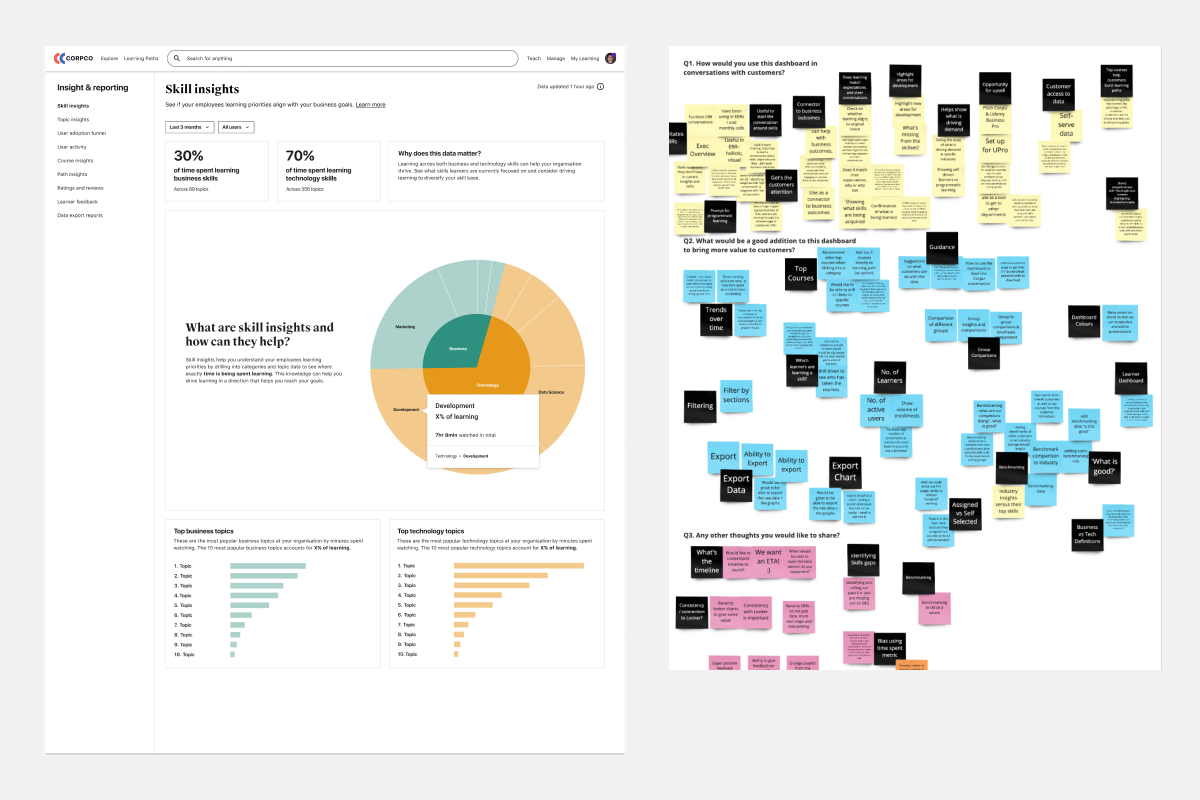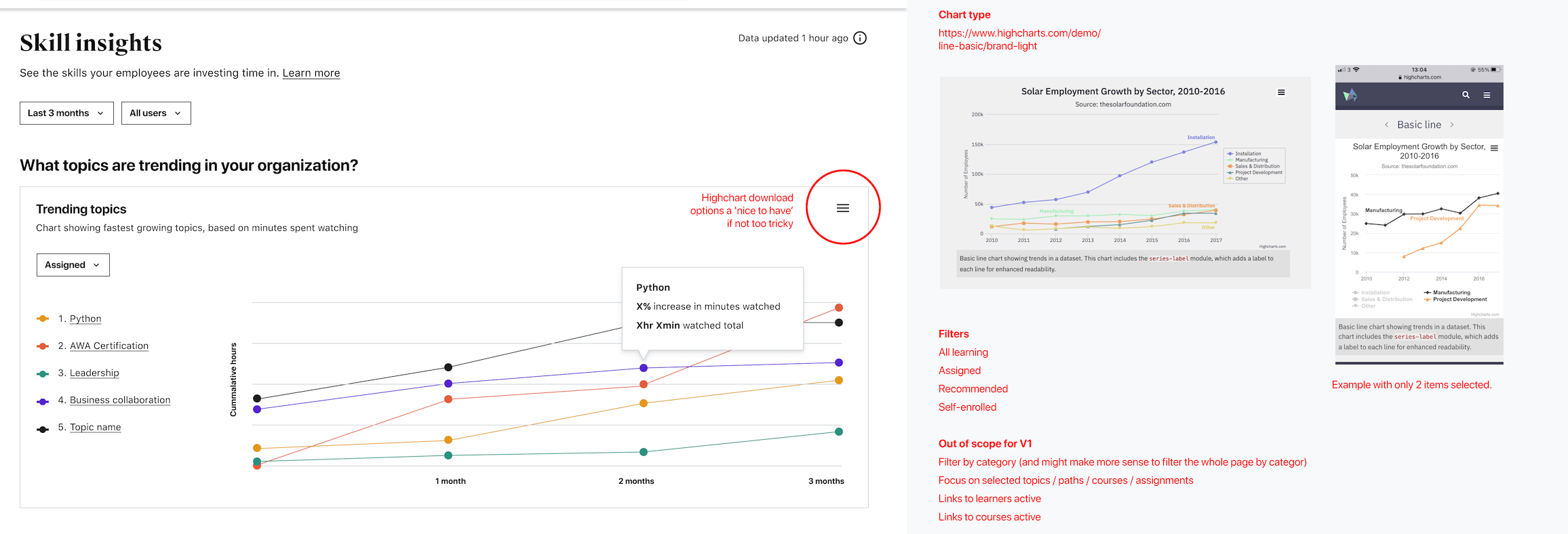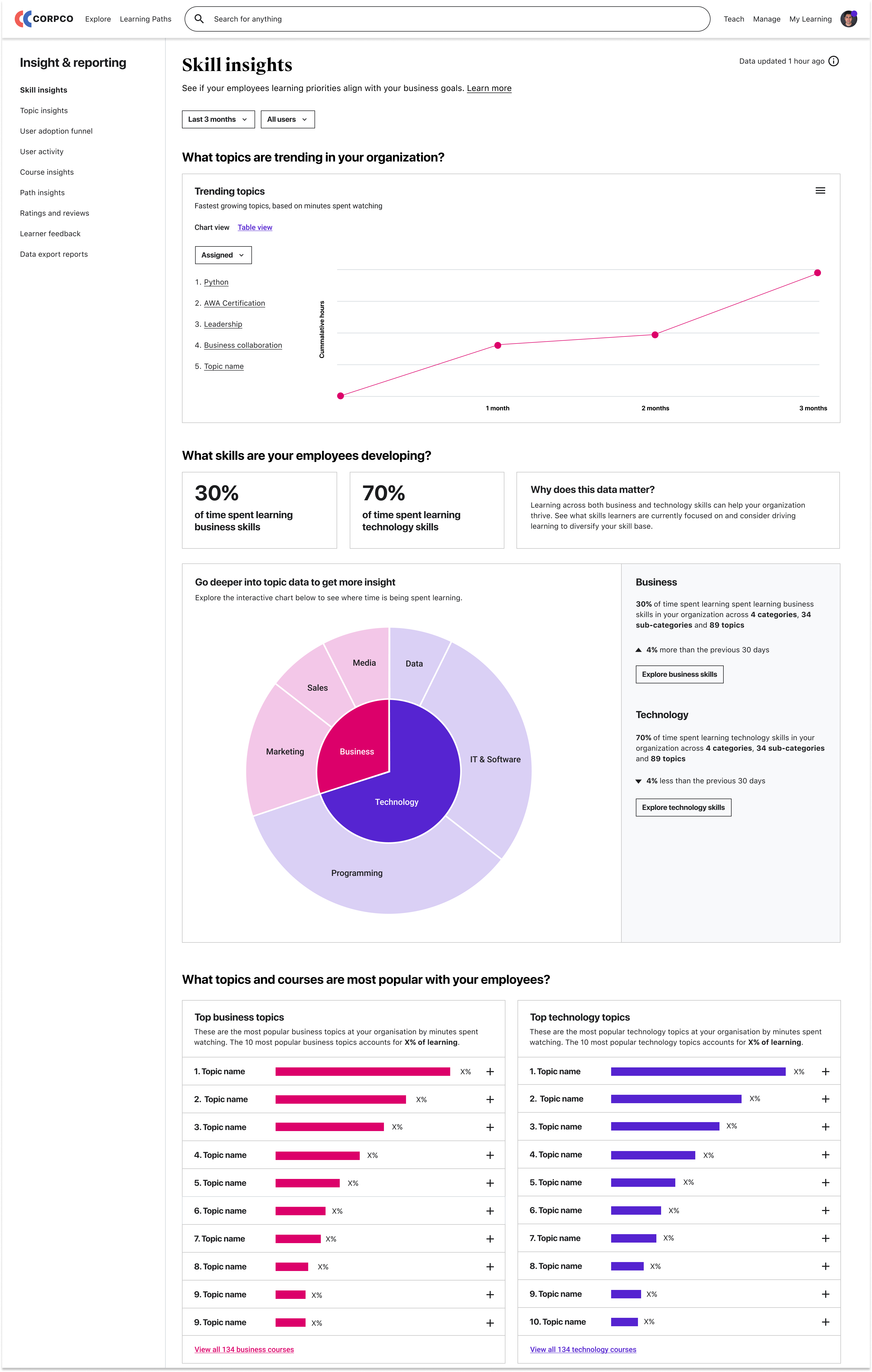Case study 1: Skill insights
Helping learning and development leaders understand the skills being developed within their organisations.
Project outline
- Context
- My role and project approach
- Project goal
- Users and audience
- Scope, constraints & challenges
- Phase 1:Understanding the problem and initial research
- Phase 2: Collaborative workshops and ideation
- Phase 3: Internal beta (V0) + internal feedback
- Phase 4: Customer beta (V0.1) + usertesting
- Phase 5: Customer release (V1)
- Outcomes & lessons learnt
Context
This project was part of an online learning platform that enables instructors to create courses which support millions of students to learn and develop new skills. My focus was on the B2B side of the business, which was a subscription based service that organisations can use to provide their employees with a suite of curated online learning, including business, technology and personal development skills. When I initially joined the insights project team, the focus was on showing learning activity and time spent learning to our customers. As a team we believed that we could demonstrate a more holistic idea of the value being provided to our customers.
My role and approach
- My role on this project was senior product designer.
- I directed all the design efforts and designed and facilitated most of the collaborative team workshops.
- I collaborated with other team leads on the team strategy, and research.
- I worked with the rest of the team to progress the development of the project.
- My team pod consisted of myself, a product manager, a lead engineer/engineer manager and 3/4 additional engineers.
- The project approach was highly collaborative and iterative from the start. The team had been working together for a while, and we had been using feedback from regular retros to refine and develop our team processes.
- We collaborated in creating interactive prototypes using real data.
- We released in three key phases, to help us gain insights and evolve the project based on feedback from customers and internal stakeholders.
Project goal
The team's hypothesis was that enabling learning and deveopment leaders to be able to better understand and target relevant skills, would increase the value of the product within their organisations. Our goal for this specific project was to help learning and development teams understand what skills were being developed in their organisations, so that they could take steps to drive learning towards skills that are relevant to their learning needs & business goals.
Users and audience
I ran a number of persona alignment workshops, to help the team align on existing knowledge about our customers and identify gaps in our knowledge. We arrived at 5 key personas, which also helped align between teams within the wider portfolio. My team made the decision to focus on 'Learning and development leaders' within medium size organisations as they had both influence in terms of renewals, but were also hands on in terms of programme management, and would benefit from more in-depth learning insights.


Scope, constraints & challenges
- The team budgeted for a quarter, to release a skills based dashboard (this included phases 2, 3 & 4). It was our priority project but it was not the only thing that was being worked on by the team, so the allocated schedule was ambitious. It took closer to two quarters to deliver, partly due to unanticipated projects being prioritised, but we managed to include more than initially anticipated due to the extended deadline.
- The team had to work within the existing taxonomy and topic data structure, which were also in the process of being significantly updated and revised by another team. This meant that my team had to align our projects, to ensure that neither project would block the other, while also considering unspecified changes coming in the future.
- The biggest challenge for this project was maintaining collective focus and momentum. There were a number of other projects and initiatives in progress simultaneously, and we had to regularly regroup and ensure that this priority project was going in the right direction.
- Accessibility & ensuing UI quality for the beta was also a challenge due to the rapid nature of development and differing ideas of what a beta should be. To help us align we spent some time early in the project defining quality as a team, and we were very specific on what we would (and wouldn't) compromise on for the beta delivery.
Phase 1: Understanding the problem and initial research

Collaborative workshops and ideation



Phase 3: Internal beta (V0) + internal feedback

Phase 4: Customer beta (V0.1) + usertesting

Phase 5: Customer release (V1)
Skills dashboard - chart spec

Skills dashboard final UI design

Outcomes
- Successfully being used by internal teams to support sales and renewals
- Successfully being used by internal learning and development team to support learning programme management
- Positive feedback from customers in the Beta programme
- Additional features and functionality updates being requested
- Project gained further investment (based on success of Beta & initial release)
Lessons learnt
- Mini-sprints (a condensed design sprint) can be an engaging & collaborative way to kick-off projects, even when there isn't time to complete a full sprint, or if the project is partially defined.
- Rapid collaboration can be uncomfortable at times, but it can also be motivating and fun. It's important to get the balance right, and ensure everyone on the team understands the process and has an opportunity to give feedback.
- Prototypes using real data significantly increase engagement with customers and stakeholders significantly.
- Accessibility needs to start at the beginning of a project. While we did a good job of ensuring accessibility standards, post prototype, it would have been easier and more efficient if we had started earlier in the process.
- Involving internal stakeholders and experts early in the process meant we got lots of early feedback, which supplemented customer feedback throughout the project.
Find out more
To find out more about this project and my process get in touch.
Back to top | Back to portfolio